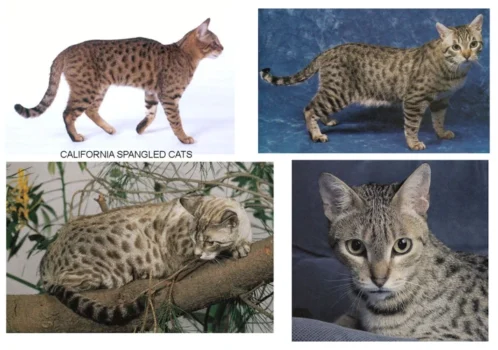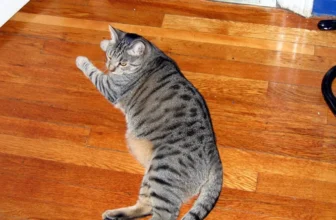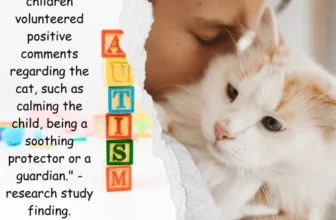Introduction
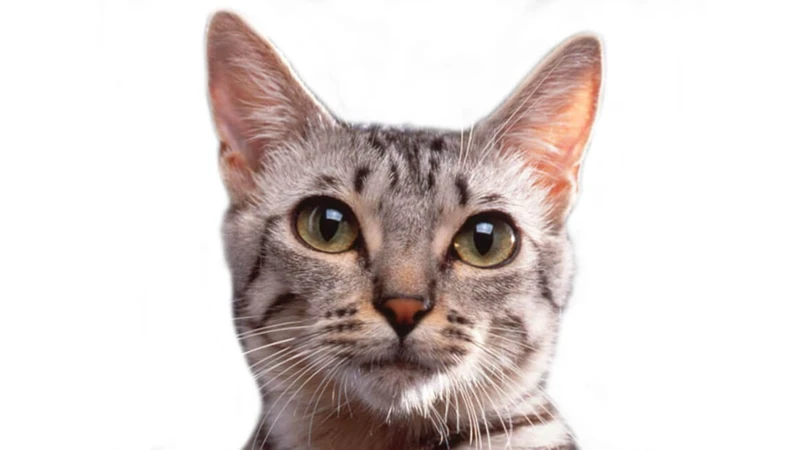
As pet owners, we want our furry friends to be happy, healthy, and full of life. However, just like humans, animals can also suffer from various health conditions that can severely impact their behavior and overall well-being. This is particularly true for California spangled cats, a unique breed known for their intelligence, athleticism, and affectionate personalities. In this article, we will dive into the influence of health conditions on the behavior of California spangled cats, exploring the different ways in which health issues can affect their behavior and how we can help care for them. So, let’s take a closer look at the relationship between health and behavior in these beautiful felines.
About California Spangled Cats
California Spangled Cats are a beautiful and unique breed that was first developed in the 1980s. They are known for their striking spotted coats and their resemblance to wild cats such as leopards and ocelots. These cats are medium-sized and muscular, with a distinctively athletic build that allows them to be excellent climbers and jumpers.
Personality and Behavior: California Spangled Cats are intelligent, curious, and energetic creatures that require proper exercise and stimulation to thrive. They are highly social animals and usually enjoy interacting with their owners and other cats. They are also known for their territorial behavior and may take some time to adjust to new surroundings or other pets.
Environment: These cats need plenty of space to climb and play. Providing them with climbing spaces and scratching posts can help satisfy their natural urge to climb and scratch. California Spangled Cats are also known for their love of sunshine, so a sunny spot with a comfortable bed is also a must.
Traits: California Spangled Cats are unique in that they are a domesticated breed designed to resemble wild cats. They are medium-sized with a muscular, athletic build, and have a spotted coat that comes in a variety of colors. They are also known for their intelligence and love of play.
Children and California Spangled Cats: California Spangled Cats are generally good with children and make great family pets. However, it is important to supervise children around cats and teach them how to properly interact with them.
Aggression: Like all cats, California Spangled Cats can become aggressive if they feel threatened or cornered. However, with proper socialization, training, and exercise, this is less likely to occur. For more information on dealing with aggression in cats, see our guide California Spangled Cats Aggression Tips and Tricks.
Destructive Behavior: California Spangled Cats, like all cats, may display destructive behavior such as scratching furniture or climbing curtains. Providing them with proper climbing and scratching outlets can help reduce destructive behavior. For more information, see our guide on California Spangled Cat Destructive Behavior.
Behavioral Changes Associated with Health Conditions
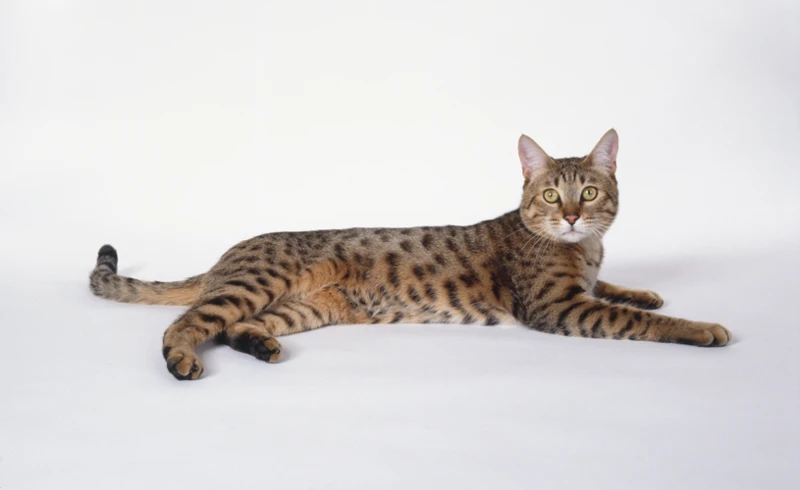
The health of a California Spangled cat is vital to its overall wellbeing and behavior. When a cat is experiencing health issues, it can lead to a range of behavioral changes that may cause concern for its owner. These changes can be mild or severe, and may include depression, anxiety, and aggression. The physical discomfort from health problems can also lead to changes in behavior. Understanding the behavioral changes associated with health conditions in California Spangled cats is important for owners to ensure their pets receive proper care and attention. In this section, we will explore common health conditions that can lead to behavioral changes in California Spangled cats.
Urinary Tract Problems
Urinary tract problems are a common health issue that can lead to behavioral changes in California Spangled Cats. These problems can include bladder infections, kidney stones, and blockages. These conditions can cause discomfort, pain, and frequent urination, which can lead to urinating outside of the litter box.
Symptoms of urinary tract problems can include excessive grooming of the genital area, frequent and painful urination, blood in urine, and reduced appetite and activity levels. If you notice any of these symptoms, it is important to take your California Spangled Cat to the veterinarian immediately.
Treatment for urinary tract problems usually involves antibiotics, pain medication, and special prescription diets. The veterinarian may also recommend increasing your cat’s water intake and providing low-stress litter boxes in multiple locations.
Prevention of urinary tract problems can be achieved by providing your California Spangled Cat with plenty of fresh water, feeding them a healthy, low magnesium diet, and ensuring they have access to clean litter boxes in low-stress areas. Regular veterinary checkups can also help to catch any potential urinary tract issues early.
It is important to address urinary tract problems promptly, as they can cause significant discomfort and pain in California Spangled Cats. By providing proper care, prevention, and treatment, you can ensure that your cat remains healthy and happy.
Pain and Discomfort
When a California Spangled cat experiences pain or discomfort, their behavior may be affected, causing them to act out of character. Some common sources of pain and discomfort that can affect cats include dental issues, arthritis, and injuries. A cat with dental pain may stop eating or become less social, while a cat with arthritis may be less active or experience difficulty jumping. It’s important to be aware of any changes in your cat’s behavior, as these could be signs of underlying pain or discomfort.
If you notice any sudden changes in your cat’s behavior, such as decreased appetite, decreased activity level, or decreased grooming, it’s important to take them to the veterinarian for an assessment. The veterinarian can determine whether there is an underlying health issue causing the changes in behavior and provide recommendations for treatment.
To help your cat manage pain and discomfort, there are several things you can do. Providing comfortable bedding and a cozy environment where they can rest can help alleviate discomfort. Additionally, providing appropriate pain medication as prescribed by the veterinarian can help your cat feel more comfortable.
It’s important to note that cats are very good at hiding pain, so it’s important to monitor your California Spangled cat closely for any signs of discomfort. By doing so, you can ensure that they receive prompt medical attention if needed and help them feel their best.
Internal Link: For information on California Spangled cat’s territorial behavior, check out our article on Territorial Behavior of California Spangled Cats.
Hyperthyroidism
Hyperthyroidism is a common health condition among California Spangled Cats. This is a disorder that occurs when the thyroid gland becomes overactive and produces too much thyroid hormone. This condition can cause a range of symptoms, including weight loss despite an increase in appetite, increased thirst and urination, restlessness, and hyperactivity.
Cause of Hyperthyroidism
The exact cause of Hyperthyroidism in California Spangled Cats is not known, but it is believed to be related to a combination of genetic and environmental factors. Some studies suggest that older cats and those that are fed diets high in iodine or fish are more likely to develop this condition.
Diagnosis and Treatment of Hyperthyroidism
If you notice any symptoms of hyperthyroidism in your California Spangled Cat, it’s essential to take them to a veterinarian immediately. The vet can diagnose the condition by checking the cat’s thyroid hormone levels through a blood test.
Several treatment options are available for hyperthyroidism, including medication, surgery, and radiotherapy. Medication is the most common treatment for this condition and works by decreasing the production of thyroid hormone in the thyroid gland.
Caring for a California Spangled Cat with Hyperthyroidism
If your California Spangled Cat has been diagnosed with hyperthyroidism and put on medication, it’s important to follow the vet’s instructions carefully. You should also monitor your cat’s weight, appetite, and behavior closely and report any changes to the veterinarian.
In addition to medication, you can also help manage your cat’s hyperthyroidism by providing a low-iodine diet, ensuring they have plenty of fresh water available, and creating a calm and stress-free environment for them to relax in.
Preventing Hyperthyroidism
While it’s not entirely possible to prevent hyperthyroidism in California Spangled Cats, there are steps you can take to reduce the risk of your cat developing this condition. These include regular veterinary checkups, providing a balanced, low-iodine diet, and avoiding feeding your cat fish or tuna.
Hyperthyroidism is a common health condition among California Spangled Cats. Still, it can be managed with proper treatment and care. By monitoring your cat’s symptoms carefully and working closely with your veterinarian, you can help ensure that your cat leads a healthy and happy life.
Behavioral Changes from Medications
When a California Spangled cat is dealing with an illness or condition, medications may be prescribed to help alleviate symptoms or manage the condition itself. However, it’s important to note that some medications can cause behavioral changes in cats, including California Spangled cats. Some common side effects of medication may include:
- Drowsiness or lethargy
- Increased or decreased appetite
- Agitation or restlessness
- Increased vocalization
- Changes in litter box habits
It’s important to pay attention to any changes in behavior after starting medication and speak to your veterinarian if you’re concerned. In some cases, your vet may be able to adjust the dosage or switch to a different medication to alleviate any negative side effects.
It’s important to follow medication instructions carefully and never give your California Spangled cat medication meant for humans, as this can be dangerous and even fatal. Your vet can provide specific instructions for administering medication to your cat.
To prevent any changes in behavior from medication, it’s also important to keep your California Spangled cat’s diet and exercise routine consistent, as well as providing them with an enriched environment that meets their unique needs. You can learn more about the unique traits and needs of California Spangled cats in our article on California Spangled Cat Traits, Creating the Ideal Environment, and the importance of giving them the climbing space they need in our article on Climbing Space. It’s also important to teach children how to properly interact with cats, which you can learn more about in our guide to California Spangled Cats and Children. By providing proper care and attention, you can help your California Spangled cat stay healthy and happy.
Caring for California Spangled Cats with Health Conditions
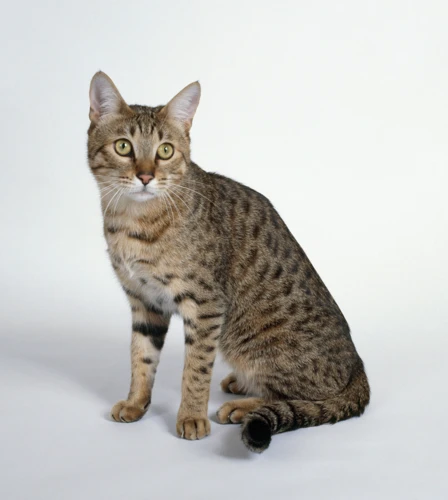
As pet owners, it can be heartbreaking to watch our beloved California Spangled Cats suffer from health conditions. However, with the right care and attention, we can help our furry friends live happy and healthy lives. Offering proper veterinary care, diet and nutrition, environment and enrichment, and grooming and hygiene can all be key factors in ensuring our cats receive the best possible care. Let’s explore these care aspects in more detail.
Regular Veterinary Checkups
Keeping your California Spangled Cat healthy requires regular veterinary checkups. As a responsible pet owner, it’s important to ensure that your cat receives proper medical attention, including routine checkups and preventative care. Regular vet visits can help detect health problems early, preventing them from becoming serious issues later on.
During vet checkups, your cat’s overall health will be assessed, including their weight, heart rate, respiratory rate, and temperature. The vet will also perform a thorough physical exam, checking for any abnormalities or signs of illness.
In addition to physical exams, the vet may also recommend certain tests to evaluate your cat’s health. These may include blood work, urinalysis, and fecal exams. These tests can help detect underlying health issues that may not be visible during a physical exam.
It’s recommended to schedule a veterinary checkup for your California Spangled Cat at least once per year, and more frequently for senior cats or those with underlying health conditions.
Regular vet checkups can help ensure that your cat receives proper medical attention, including preventative care measures such as vaccinations and parasite prevention. Your vet can also discuss any concerns or questions you may have about your cat’s health, behavior or diet, and may recommend changes to better optimize your cat’s health.
To ensure you don’t forget to schedule regular vet checkups, consider setting reminders or keeping a schedule. Make sure to address any concerns or observations with your vet, and take any advice they may give seriously. By providing your cat with regular veterinary care, you can help ensure they live long, healthy lives.
Here’s an overview of the benefits of regular veterinary checkups for your California Spangled Cat:
| BENEFITS | EXPLANATION |
| Preventative Care | Prevent illnesses and injuries before they become serious issues |
| Early Detection of Health Issues | Allows for early intervention and treatment, improving long-term prognosis |
| Customized Care Plan | Allows for tailored care and management of health conditions |
| Vaccinations and Parasite Prevention | Protects your cat from common diseases and parasites |
Regular vet checkups are an essential component of responsible cat ownership. By appropriately caring for your cat, you can help ensure they live long, happy, and healthy lives.
Diet and Nutrition
Maintaining a healthy diet is crucial for California Spangled Cats with health conditions to improve their overall well-being. A balanced diet can help prevent and manage various health conditions, including urinary tract problems, obesity, and diabetes. Here are some dietary recommendations for caring for a California Spangled Cat with health conditions:
| Nutrient | Role in Cat’s Health | Sources |
|---|---|---|
| Protein | Important for muscle growth and repair, supports a healthy immune system and helps maintain proper pH of urine | Meat, poultry, fish |
| Fiber | Regulates digestion, reduces the risk of constipation, and helps control blood sugar levels | Fruits, vegetables, grains |
| Water | Keeps the body hydrated and flushes out toxins from the kidneys and bladder | Drinking water, wet food |
| Fat | Provides energy and is essential for healthy skin and coat | Fish, flaxseed, poultry |
| Carbohydrates | Provide energy and fiber, supports digestive health and controls blood sugar levels | Grains, fruits, vegetables |
It’s important to consult with a veterinarian to determine the specific dietary requirements for a cat with a health condition, as different conditions may require specific dietary modifications. It may also be necessary to feed the cat smaller, more frequent meals to help prevent weight gain or manage blood sugar levels.
It’s also important to note that some foods can be harmful to cats, especially those with health conditions. Foods high in sodium, sugar, and fat should be avoided. Additionally, some cats may have allergies or intolerances to certain foods, so it’s important to introduce new foods slowly and watch for any adverse reactions.
Providing a cat with a balanced diet that meets their specific dietary requirements can help manage and prevent health conditions. Consult with a veterinarian for specific dietary recommendations and be mindful of the types of foods given to cats.
Environment and Enrichment
California spangled cats are known for their active nature, and providing an environment that caters to their needs is essential for their mental and physical well-being. Here are some ways to create an enriched environment for your feline friend:
1. Provide Vertical Space: Cats love to climb and perch, so having tall shelves, cat trees, and perches can be beneficial. This not only gives your cat a place to exercise and play, but it also allows them to observe their surroundings.
2. Interactive Toys: Interactive toys such as puzzle feeders, laser pointers, and toys on strings can keep your cat entertained and mentally stimulated. This helps prevent boredom, which can lead to destructive behavior.
3. Scratching Posts: Scratching is a natural behavior for cats, and providing them with a designated scratching post can prevent them from damaging furniture. Choose a post made of materials such as sisal rope or cardboard, which cats love to scratch.
4. Comfortable Resting Areas: California spangled cats are known to be active, but they also need rest. Providing comfortable areas to sleep or relax, such as soft beds or cozy blankets, can help your cat relax and feel comfortable in their environment.
5. Outdoor Access: If possible, consider allowing your cat access to the outdoors in a safe and controlled manner. This can provide them with new sights, smells, and experiences to keep them stimulated.
Creating an enriched environment for your California spangled cat is an ongoing process, and it is important to continuously assess and adapt their environment to meet their changing needs. By providing an environment that promotes physical and mental stimulation, you can help ensure your cat lives a happy and healthy life.
Grooming and Hygiene
Maintaining good grooming and hygiene practices is crucial in promoting the overall health and wellness of California Spangled Cats. Here are some tips to keep them clean and healthy:
- Regular Brushing: Regularly brushing their hair is important to prevent matting, reduce shedding, and distribute natural oils throughout their fur. Brushing also helps to remove loose fur and debris, which can prevent hairballs and other digestive issues.
- Oral Hygiene: Just like humans, dental hygiene is important to keep their teeth and gums healthy. Consider frequently brushing their teeth and providing chew toys.
- Bathing: While California Spangled Cats do not require frequent bathing, they may occasionally need a bath if they get into something dirty or smelly. Be sure to use cat-safe shampoo and warm water, and to thoroughly dry them after the bath.
- Paw Care: Regularly cleaning their paws is important to prevent infection and irritation. Keep their litter box clean and consider providing them with a scratching post to help naturally maintain their claws.
Taking care of their grooming and hygiene needs can not only keep them healthy, but also promote a loving and comfortable relationship between you and your feline companion.
Preventing Health Conditions in California Spangled Cats
As a pet owner, it is important to take proactive steps in preventing health conditions in your California Spangled cat. While some conditions are genetic or unavoidable, there are steps you can take to minimize the risk of your feline friend developing certain health problems. With a little extra attention to their care and wellbeing, you can help ensure that your California Spangled cat remains happy and healthy for years to come. Let’s take a closer look at some of the preventative measures you can take to keep your cat in optimal health.
Preventative Veterinary Care
One of the most important aspects of keeping California Spangled Cats healthy is preventative veterinary care. This includes regularly scheduled checkups with a veterinarian to ensure that any potential health issues are caught early on.
Benefits of Preventative Veterinary Care
Taking your cat to the vet for preventative care can have numerous benefits, including:
| Benefit | Description |
|---|---|
| Early detection and treatment of health issues | Regular checkups with a vet can help identify potential health problems before they become more serious and require more extensive treatment. |
| Increased lifespan | By identifying and treating health issues early, cats are more likely to live longer and healthier lives. |
| Improved quality of life | Preventative care can help improve a cat’s overall well-being by addressing any health issues that may be causing discomfort or pain. |
Components of Preventative Veterinary Care
Preventative veterinary care typically includes a combination of the following components:
- Annual physical exams
- Vaccinations
- Parasite prevention (flea, tick, and heartworm prevention)
- Dental care
- Blood work and other diagnostic tests
Choosing the Right Vet
When it comes to preventative veterinary care, it’s important to choose the right vet for your California Spangled Cat. Look for a vet who is experienced in dealing with cats and who you feel comfortable communicating with. You may also want to consider factors such as the location of the vet’s office, their hours of operation, and their fees.
Conclusion
Preventative veterinary care is essential for keeping your California Spangled Cat healthy and ensuring a long and happy life. By taking the time to schedule regular checkups and addressing any health issues early on, you can help your cat live their best life.
Proper Nutrition and Exercise
Maintaining a healthy diet and exercise routine are crucial for California Spangled cats’ overall well-being and can help prevent many health conditions. Here are some tips to ensure your cat is eating a balanced diet and getting enough exercise:
Nutrition:
- Choose high-quality, grain-free cat food that is appropriate for your cat’s age and health needs. Consult with your veterinarian for recommendations.
- Avoid feeding your cat table scraps, as they may contain ingredients that can be harmful to their health. Stick to feeding them appropriate cat food.
- Provide fresh water at all times and ensure that your cat is drinking enough water to avoid dehydration.
- Introduce healthy snacks into your cat’s diet, such as small pieces of cooked chicken or canned tuna (in water, not oil).
Exercise:
- Provide your cat with toys that encourage activity, such as feather wands, climbing trees, and toy balls.
- Set aside time each day to play with your cat. This not only provides exercise, but also strengthens the bond between you and your pet.
- Encourage your cat to climb and explore their environment. This is natural for cats and provides physical stimulation.
- If your cat is overweight or has joint issues, consult with your veterinarian for appropriate exercise routines that won’t exacerbate any existing health conditions.
Remember that a combination of proper nutrition and exercise is key when it comes to your California Spangled cat’s health and well-being. Consistency and regular check-ups will also help keep them in the best possible condition.
Stress Reduction Techniques
Stress can have a major impact on the behavior and overall health of California Spangled Cats. It’s important to implement stress reduction techniques to keep your feline friend healthy and happy. Here are some techniques that can help reduce stress in California Spangled Cats:
- Provide Safe Spaces: Create areas where your cat can retreat to when they feel stressed. These safe spaces should be quiet and away from any potential stressors, such as other pets or loud noises.
- Playtime: Engage your cat in daily playtime activities. This can include interactive toys, such as feather wands or laser pointers, to help your cat relieve any built-up energy and reduce stress.
- Calming Music: Playing calming music can help soothe your cat and create a calming environment. There are even specially designed cat music playlists available on streaming services.
- Scents: Certain scents, such as lavender or chamomile, can have a calming effect on cats. Consider using scent diffusers or candles to create a calming environment for your cat.
- Positive Reinforcement: Rewarding your cat with treats and praise for good behavior can help reduce stress levels and improve their overall behavior. Positive reinforcement training can also help improve your cat’s overall mood and reduce stress.
- Provide Adequate Resources: Make sure that your cat has access to adequate resources, such as food and water bowls, litter boxes, and scratching posts. Not having these resources available can lead to stress and anxiety in cats.
By implementing these stress reduction techniques, you can help your California Spangled Cat live a happier, healthier life. However, it’s important to remember that every cat is unique and may respond differently to different techniques. Pay close attention to your cat’s behavior and adjust your stress reduction techniques accordingly.
Conclusion
After reviewing the various health conditions that can affect California Spangled Cats and the corresponding behavioral changes, it is clear that proper care and preventative measures are critical to ensuring a happy and healthy feline companion. From urinary tract problems to hyperthyroidism, these health conditions can significantly impact a cat’s behavior and quality of life. However, by prioritizing regular veterinary check-ups, a well-balanced diet, and a stress-free environment, pet owners can help prevent and mitigate the impact of these conditions.
It’s also essential to understand the impact of medication on a cat’s behavior. While medication can be crucial for treating health conditions, it can also lead to behavioral changes such as lethargy or aggression. Pet owners must work closely with their veterinarian to monitor any such changes and adjust their treatment plan accordingly.
Overall, providing attentive care for California Spangled Cats can help ensure that these beautiful creatures live long, healthy lives. By paying attention to their unique health needs, providing a comfortable and stress-free environment, and remaining attentive to the signs of illness or discomfort, cat owners can cultivate a wonderful bond with their feline companions. Remember, a happy cat equals a happy cat owner!
Frequently Asked Questions
Can California Spangled Cats tolerate pain well?
Like any other cats, California Spangled Cats can tolerate pain but may exhibit different behaviors to indicate they are in discomfort or pain. It is important to observe their behavior to identify any pain-related symptoms so you can address them immediately.
What are common urinary tract problems in California Spangled Cats?
California Spangled Cats are prone to urinary tract problems such as crystals, blockages, and infections. These issues can be caused by dehydration, diet, or genetics.
What are the signs of hyperthyroidism in California Spangled Cats?
Common signs of hyperthyroidism in California Spangled Cats include increased appetite, weight loss, and hyperactivity. Other symptoms may include vomiting, diarrhea, and aggression.
What medications can affect the behavior of California Spangled Cats?
Several medications can affect the behavior of California Spangled Cats, including painkillers and steroids. These drugs can cause lethargy, confusion, and changes in appetite.
How often should I take my California Spangled Cat to the vet?
It is recommended to take your California Spangled Cat to the vet at least once a year for a routine check-up. However, if your cat shows any signs of illness or discomfort, it is important to bring them in for an evaluation.
What type of diet is best for California Spangled Cats?
California Spangled Cats require a balanced and nutritious diet that provides them with the necessary nutrients, vitamins, and minerals. It is recommended to feed them high-quality dry or wet food and to avoid feeding them table scraps or human food.
How can I create a stimulating environment for my California Spangled Cat?
You can create a stimulating environment for your California Spangled Cat by providing them with toys and activities that challenge them mentally and physically. This can include puzzle toys, scratching posts, and interactive toys that require problem-solving skills.
What is the best way to groom my California Spangled Cat?
California Spangled Cats have short hair and require minimal grooming. You can brush their coat once or twice a week to remove loose hair and keep their coat shiny. Additionally, you should trim their nails and clean their ears regularly.
Can stress cause health problems in California Spangled Cats?
Yes, stress can cause several health problems in California Spangled Cats, including digestive issues, urinary tract problems, and hair loss. It is important to provide them with a stress-free environment and to identify and address any sources of stress in their environment.
What role does exercise play in preventing health conditions in California Spangled Cats?
Regular exercise can help prevent several health conditions in California Spangled Cats, including obesity, diabetes, and heart disease. It is recommended to provide your cat with opportunities for physical activity, such as playtime and access to climbing structures.

